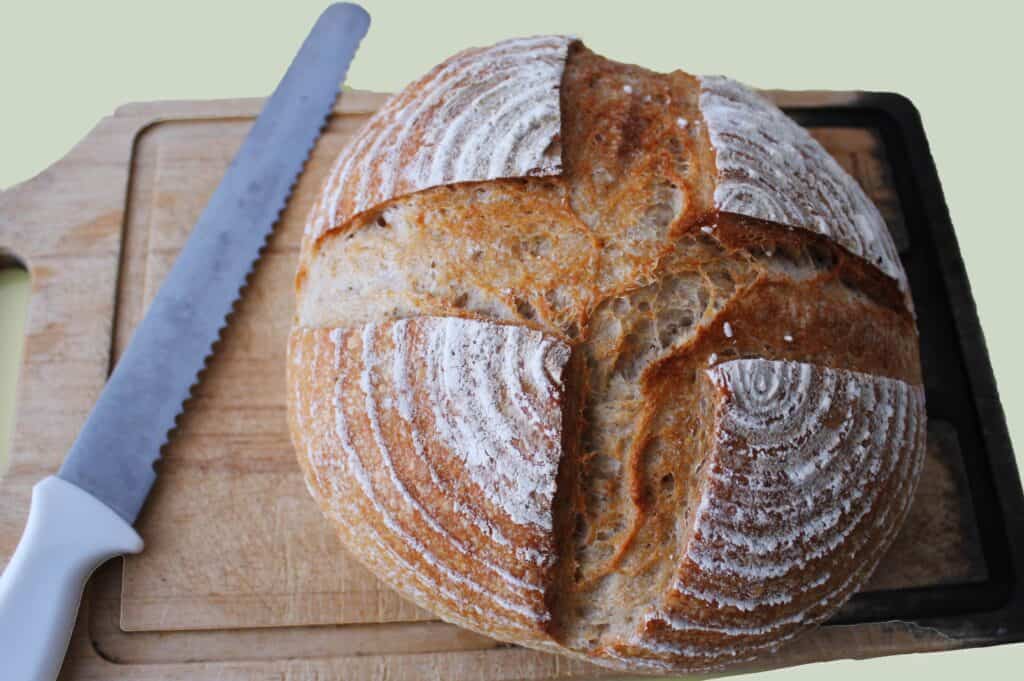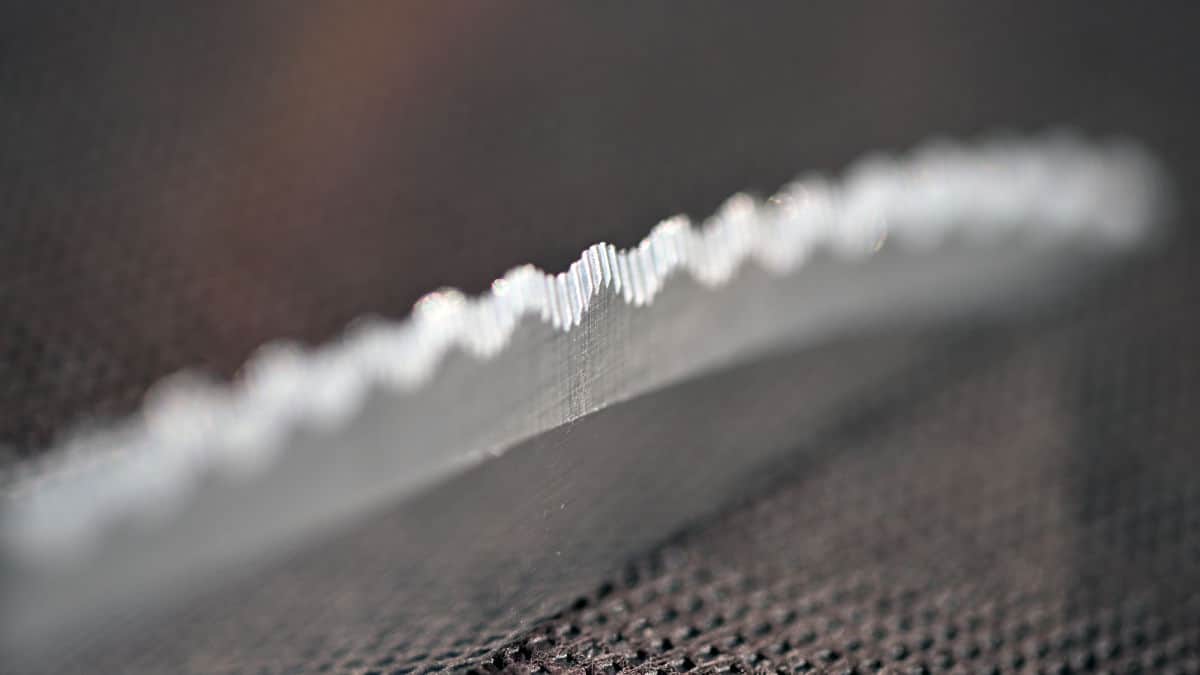When you visit a merchant by clicking a link on this site we may make a commission on anything you buy (at no additional cost to you). Affiliate programs and affiliations include, but are not limited to Amazon Associates and the eBay Partner Network.”
A serrated knife is an essential tool in any well-equipped kitchen. With its unique saw-like blade, featuring a series of sharp teeth or ridges, it is designed to cut through a variety of tough or fibrous materials with ease. The versatility of a serrated knife allows it to be used for tasks ranging from slicing crusty loaves of bread to precisely cutting delicate fruits and vegetables.
One of the most common uses for a serrated knife is cutting bread, as its sharp teeth can easily pierce through the hard crust without crushing the soft interior. In addition to bread, serrated knives are also ideal for slicing through meats with gristle or sinew, and even hard vegetables like tomatoes or squash, thanks to their ability to maintain a firm grip on slippery surfaces.
Aside from these more traditional uses, serrated knives have other applications as well, such as peeling pineapple, torting layer cakes, and even slicing soft and fluffy cakes. The key to their effectiveness lies in the distribution of pressure along the knife’s edge, which allows for precise and efficient cuts on a variety of food items.
The Importance of a Serrated Knife
A serrated knife is a vital tool in any kitchen, as it excels at slicing through various types of food with ease. Its unique toothed design sets it apart from a straight blade knife, making it a necessary addition to every cook’s collection.
Types of Serrated Knives
There are several types of serrated knives, each suited to specific tasks:
- Bread Knife: The most common type of serrated knife, used to slice through crusty bread without crushing the soft interior.
- Tomato Knife: A smaller serrated knife designed for slicing through delicate, smooth-skinned fruits and vegetables, such as tomatoes and peppers.
- Steak Knife: While usually featuring a straight blade, some steak knives come with serrated edges, designed for easy cutting of meats with differing textures.
- Carving Knife: A lengthy serrated blade for slicing through roasted meats without tearing them apart.
These knives serve a variety of purposes in the kitchen, making them indispensable tools for preparing and serving a wide range of dishes.
Serrated Knife vs. Straight Blade Knife
Serrated and straight blade knives each have their advantages and disadvantages, which is why it’s essential to have both in your kitchen arsenal:
- Cutting Technique: A serrated knife “bites” into the food, reducing the chances of slippage, while a straight blade knife relies on pushing and cutting through the ingredients.
- Sharpness: Serrated knives can maintain their edge for a long time as only the teeth make contact with the cutting surface. Straight blade knives require more frequent sharpening due to the entire edge making contact with the food being cut.
- Versatility: A serrated knife is perfect for foods with tough exteriors and soft interiors, such as bread and melons, while straight blade knives are more suited for precision tasks like mincing and chopping.
- Sharpening: Straight blade knives can be easily sharpened at home using a honing rod or whetstone, while serrated knives require a specific method to sharpen each tooth individually.
By understanding the different uses of serrated and straight blade knives, you can ensure that you are utilizing the right tool for the task, making your kitchen endeavors more efficient and enjoyable.
Common Uses for Serrated Knives
Bread and Crusty Loaves

Serrated knives are perfect for cutting bread and crusty loaves. Their sharp, pointed teeth easily grip and slice through the tough exterior without compressing or tearing the soft interior. The serrated edge also helps distribute pressure, ensuring even and clean cuts.
Fruits and Vegetables
While not as common, serrated knives can be useful for handling delicate, squishy, and slippery fruits and vegetables like tomatoes, strawberries, lemons, and eggplants. The serrated blade assists in slicing delicate fruits and vegetables with ease, maintaining their integrity and preventing them from slipping or getting crushed.
Cakes and Icing
A serrated knife is also an excellent choice for torting a cake or slicing it into thinner layers before icing and decorating. The serrated edge allows for clean and precise cuts, without crushing or affecting the cake’s texture. Pastry chefs often use serrated knives for this purpose, as they ensure even and perfect layers.
Meats and Fibrous Materials
Serrated knives can be incredibly helpful in the kitchen when it comes to cutting meats and fibrous materials. The teeth of the serrated edge work well for meats and citrus fruits, gripping and cutting through the fibers without compressing or tearing. This makes it an essential tool for slicing through various types of meat, as well as fruits with tough skins or fibrous interiors.
Characteristics of a Quality Serrated Knife
Materials and Construction
A quality serrated knife is usually made of high-quality stainless steel, which provides durability and resistance to rust. Such knives often come with a thin but sturdy blade, making it efficient for slicing through various types of foods. Some serrated knives are made from Japanese or German steel, both of which are known for their premium quality and sharpness (source).
Serration Patterns and Blade Angles
Serrated knives used in culinary settings typically have serrations that are broader and deeper than those found on other serrated blades; they are also more pointed. The serration pattern is designed to easily slice through food with thick or resistant outer surfaces like crusty bread or tomatoes (source).
Culinary serrated knives generally have blade angles of about 30 degrees, compared to narrower angles found on other types of serrated knives. This wider blade angle contributes to the knife’s cutting ability and enables it to maintain its sharpness longer. In most cases, only one side of the blade is serrated, while the other side is flat and sharp.
Maintenance and Sharpening
The design of a quality serrated knife allows it to continue slicing efficiently even when the teeth and gullets become dull. However, regular maintenance and sharpening will ensure that your serrated knife remains in optimal condition and provides the best cutting performance.
Sharpening a serrated knife requires a different approach than with smooth-edged knives. It is important to use a specially designed sharpening tool, such as a tapered sharpening rod, to sharpen each serration one at a time. Take care to maintain the original angle of the serrations while sharpening (source).
To help prevent rust and maintain the overall quality of your serrated knife, it is essential to clean the blade properly after each use. Avoid using abrasive cleaners or soaking the knife in water for extended periods, as this can lead to rust and damage to the blade.
In summary, a quality serrated knife is an essential tool in any kitchen due to its efficient cutting ability, versatile serration patterns, and unique blade angles. Proper maintenance and sharpening will help preserve the performance and longevity of this valuable kitchen tool.
Choosing the Right Serrated Knife for Your Needs
Kitchen Needs and Preferences
When selecting a serrated knife for your kitchen, consider the types of tasks you will primarily use it for. There are varying serrated knife designs, each with its unique benefits:
- Bread knife: Ideal for slicing through crusty bread without crushing the interior, a bread knife typically features a long, slightly curved blade with wider serrations. This guide provides excellent tips on how to choose a bread knife.
- Paring knife: Generally used for more delicate tasks, a serrated paring knife has a shorter, thinner blade that is perfect for tasks like peeling and slicing fruits, trimming vegetables, and cutting through small, soft items.
- Steak knife: Designed for cutting through meat, a serrated steak knife has sharp, pointed serrations that enable clean slicing and improved cutting performance.
- Utility knife: A versatile option, the Zelite Infinity Serrated Utility Knife is an example with a 5.5″ blade ideal for various cutting tasks, including slicing fruits and vegetables, as well as handling pastries and bread.
Consider factors like handle comfort, blade length, and the quality of the steel as these all contribute to the knife’s performance, longevity, and ease of use.
Knives for Specialized Tasks
Some serrated knives have specific design features that make them better suited for particular tasks:
- Dalstrong Serrated Bread Knife: With a military-grade handle and a unique 3-step cutting method, this knife is recommended for professional cooks due to its powerful and effective cutting performance.
- Mac Knife Superior Bread Knife: Being lightweight, this bread knife allows for extended use and comfort, perfect for those who frequently slice bread or need a more agile serrated knife in the kitchen.
Remember, knowing your kitchen needs and preferences will help you choose the optimal serrated knife for your specific tasks. Whether it’s a paring knife for precision work or a utility knife for versatile cutting, understanding the right serrated knife for your needs will elevate your cutting experience and overall kitchen efficiency.
Do Sheepsfoot Blades Have A Purpose? (Cuz They’re Ugly…)
Spetsnaz Machetes – Blades Of The Russian Special Forces
What Is The Actual Purpose Of A Spear Point Knife Blade?
CRKT CEO Review – Coolest, Most Worthless Knife Ever?
How Sharp Is A Scalpel? (Is It Sharper Than A Razor?)
Can You Shave With A Knife? (Yes, Here’s How)
When you visit a merchant by clicking a link on this site we may make a commission on anything you buy (at no additional cost to you). Affiliate programs and affiliations include, but are not limited to Amazon Associates and the eBay Partner Network.”







